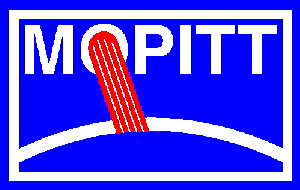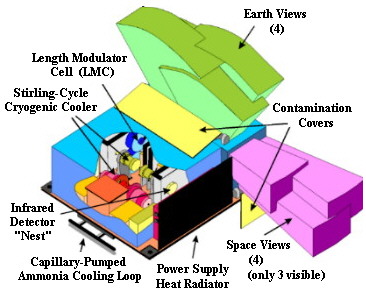Measurements
Of Pollution In The Troposphere
 The MOPITT instrument was launched on the Terra platform of NASA's Earth
Observing System (EOS) on December 18, 1999. The Terra satellite is in a 705km,
sun-synchronous orbit with a 10:30am equator crossing time. MOPITT has been
measuring carbon monoxide over the globe since that time.
The MOPITT instrument was launched on the Terra platform of NASA's Earth
Observing System (EOS) on December 18, 1999. The Terra satellite is in a 705km,
sun-synchronous orbit with a 10:30am equator crossing time. MOPITT has been
measuring carbon monoxide over the globe since that time.
Despite the fact that we all live in the troposphere, monitoring of the
tropospheric composition from space has lagged considerably behind our
monitoring of the upper regions of the earth's atmosphere mainly because of the
technical difficulty of such measurements. The presence of the earth's surface
provides considerable interference to most measurement methodologies and the
presence of clouds further impedes the mission. Overcoming these problems
requires a very precise instrument with a very high performance.
We monitor carbon monoxide because it helps us understand how the troposphere
reacts to various stimuli. These can range from natural phenomena such as the
growth of forests, through agricultural sources such as rice paddies, to
catastrophic events such as biomass burning. Most of these sources can, and
indeed are, being modified by human activity on the planet.
Carbon monoxide is particularly interesting because it shows us how chemicals
are transported in the troposphere as well as giving us information about
chemical reactions in the troposphere.
MOPITT measurements have already shown us the production of carbon monoxide
in biomass burning and its transport by atmospheric circulation systems. This
needs to be understood on a global scale and incorporated into models of
tropospheric transport.
Measurements are
made by intercepting the infra-red radiation coming from the planet and then
isolating the required signals. MOPITT is a nadir sounding instrument since this
gives the maximal chance of avoiding cloud features, but this implies that it
can "see" the surface of the planet and the desired signals must be
seen against the background of the surface radiation. The field-of-view of
MOPITT is 22 x 22km and it views four fields simultaneously by the use of a 4 x
1 array of detector elements. The field of view is also continuously scanned
through a swath about 600km wide as the instrument moves along the orbit
increasing both the spatial coverage of the instrument and the chance of finding
gaps in the cloud coverage.

MOPITT Instrument
The MOPITT instrument makes use of the principle of correlation spectroscopy
whereby a cell of the gas to be measured is used as an optical filter in the
infra-red to measure the signal from the same gas in the atmosphere. The amount
of gas in the instrument cell is modulated by varying either the pressure or the
length. In addition to the correlation technique MOPITT makes use of
mechanically cooled detectors and filters (at 100K) to enhance the overall
performance. The use of this cooling technique, which relies on Stirling Cycle
coolers supplied by British Aerospace, is relatively new in satellite
instrumentation having been used on only two civilian satellite instruments
before. The use of mechanical cooling rather than stored cryogen or radiative
cooling permits a relatively large amount of cooling - sufficient for both the
detectors and the filter systems - whilst still permitting a five year or
greater instrument life.
The MOPITT science team is international, having members from
Canada
, the
United States
and the
United Kingdom
. The instrument itself is being constructed by a consortium of Canadian
companies: COMDEV of Cambridge, Ontario, BOMEM from
Quebec City
, Hughes-Leitz from
Midland
and SED from
Saskatoon
. The instrument is funded by the Canadian Space Agency. The instrument was
tested in the
University
of
Toronto
.
MOPITT
science team
MOPITT is funded by the
Canadian Space Agency
MOPITT Prime Contractor
COM DEV
Cambridge
,
Ontario
For further information about MOPITT, contact:
Prof. James R. Drummond
Department of Physics
University
of
Toronto
60
St. George Street
,
Toronto
,
Ontario
,
CANADA
M5S 1A7
(james.drummond@.utoronto.ca)
Last updated May 13, 2007
 The MOPITT instrument was launched on the Terra platform of NASA's Earth
Observing System (EOS) on December 18, 1999. The Terra satellite is in a 705km,
sun-synchronous orbit with a 10:30am equator crossing time. MOPITT has been
measuring carbon monoxide over the globe since that time.
The MOPITT instrument was launched on the Terra platform of NASA's Earth
Observing System (EOS) on December 18, 1999. The Terra satellite is in a 705km,
sun-synchronous orbit with a 10:30am equator crossing time. MOPITT has been
measuring carbon monoxide over the globe since that time.